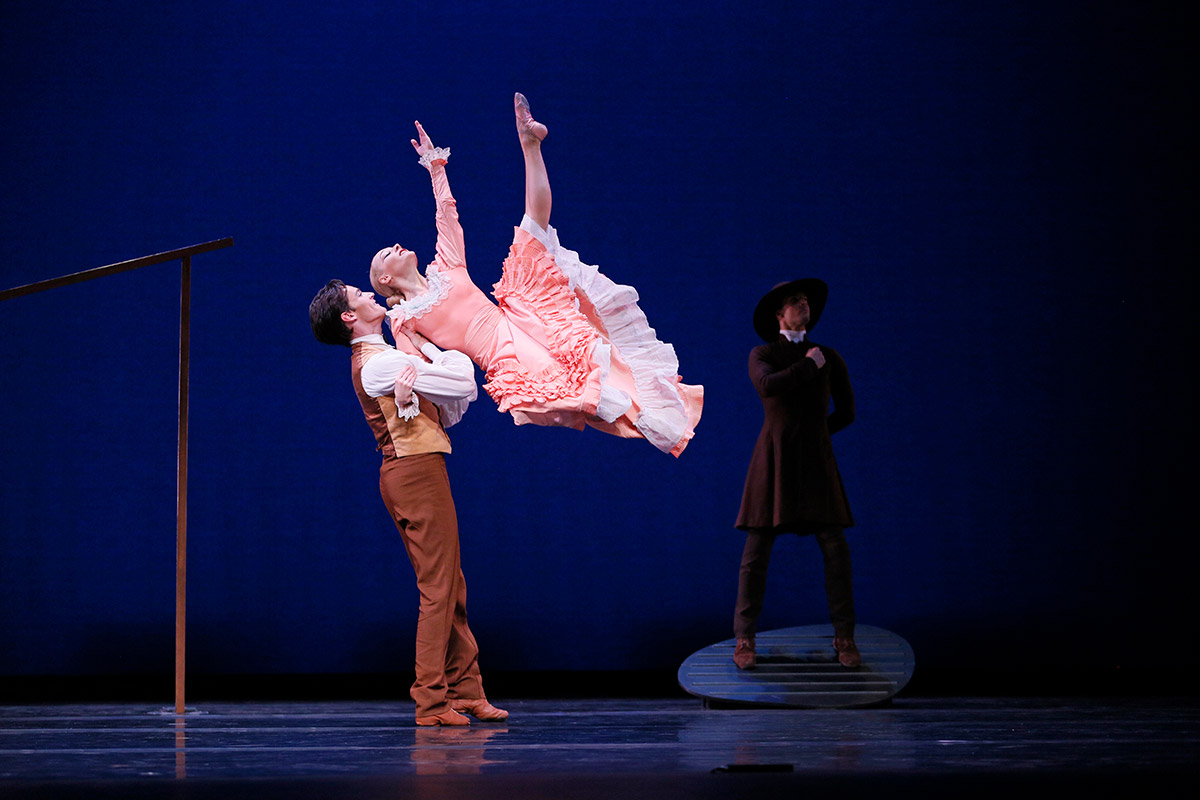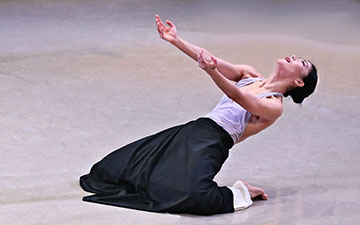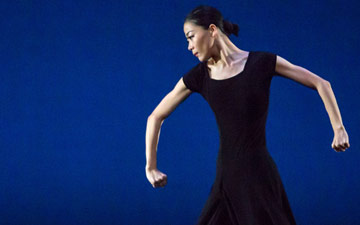
© Melissa Sherwood. (Click image for larger version)
Martha Graham Dance Company
Appalachian Spring, The Auditions
★★★★✰
New York, Alexander Kasser Theater
16 November 2019
www.marthagraham.org
www.peakperfs.org
In Conversation with Graham
For years, the Martha Graham Dance Company has been commissioning new works to perform alongside and, as the director Janet Eilber likes to say, “in conversation with” the Graham repertory. Some works rise, some fall, but few so far have left a meaningful mark. It’s hard to compete with Graham, with her fiercely original language and her instinct for drama, not to mention her lapidary sense of structure. This season, as part of the 75th anniversary of Appalachian Spring, the company and Peak Performances invited Troy Schumacher to give it a try.
Schumacher is a soloist at New York City Ballet who has formed an enterprising company of his own, BalletCollective, specializing in artistic collaborations. One of Schumacher’s talents is a keen musicality and deep musical understanding – two different things – and a hunger to work with contemporary composers. Most of his works are set to compositions made specifically for him; often the music reflects his ideas and conversations with the composer, even before he choreographs a single step. His contribution to the Appalachian Spring anniversary, The Auditions, which premiered at Peak Performances at Montclair State University (and was co-commissioned by the series) was no exception. Here, he collaborated with the American composer Augusta Read Thomas, a favorite of Pierre Boulez and winner of both a Guggenheim and a Pulitzer. Both The Auditions and Copland’s Appalachian Spring were played by the excellent International Contemporary Ensemble, with a refreshing crispness and clarity of tone under the baton of Vimbayi Kaziboni.

© Melissa Sherwood. (Click image for larger version)
Appalachian Spring, from 1944, is one of Graham’s great works, perhaps her greatest, in part because of Aaron Copland’s music. With its gleaming sense of space, it is one of the most memorable scores ever written for dance. The Noguchi set, a skeleton of a frontier house and a fence – beyond which one imagines a vast meadow or a mountain range – immediately sets the scene. There are elements in the dance that have aged poorly, like the choreography for four girlish “Followers”, whose relationship with The Preacher seems awfully coy. But as a whole the work captures the imagination; you feel the characters, know who they are, believe in their aspirations.
It’s fascinating to see new casts breathe new energy into it. Like much of Graham’s oeuvre, Appalachian Spring can feel like a museum-piece, but if you catch the right cast, everything comes alive. This performance belonged to Charlotte Landreau, in the role of The Bride, Graham’s original role. She is slight (as Graham was), and small-boned, with ardent eyes and a whip-slender waist that seems to contain a tightly wound coil of nervous energy and ardor. Her thirst for life, at first held in, then released, drives the story. At times, she seems to be walking on air, propelled by her love for this man, The Husbandman, and her hopes for the future. The Husbandman is a less expressive figure; like many Graham men he comes across as a bit of a lug, standing there, legs apart, looking like a handsome stiff. Lloyd Knight’s Preacher cuts an even more handsome figure, with his well-fitting brown suit cinched at the waist. Knight gives a sense of both the uprightness, but also the vanity of the priesthood. And the fire-and-brimstone sermon, all jumps and burning eyes, was riveting. But really, this is a world seen through a woman’s eyes – the Bride’s. I was especially touched, at this performance, by the moment in which the young married couple was finally left alone to begin their life together. Landreau smoothed her skirt as if to say, well, this is it. You wanted to wish her the best.

© Melissa Sherwood. (Click image for larger version)
That kind of clarity of intention and storytelling may be a thing of the past. In Schumacher and Thomas’s The Auditions, the situation is much more ambiguous, and unsettled. The work begins in a murky netherworld (lighting by Yi-Chung Chen), in which an angelic figure, a woman dressed in a gauzy, cloud-like garment (designs by Karen Young) stands in arabesque. She moves slowly, as if suspended in some other dimension, out of time. After a blackout, a line of six dancers in everyday clothes appears in a bright space: an office worker, two sporty types, a man in a blue shirt. They wear sneakers or street shoes. Their movements are bright, quick, athletic. They bend and extend their arms like semaphores. A one point, a woman glides through, fluttering her arms like a bird. There is a frenetic, even competitive edge to their movement, matching their bright, eager expressions. These people have something to prove.
Finally, a thin tube of light descends from above, and one of the dancers touches it. The light flickers, and, after a brief blackout, we’re back in the netherworld. Except that now there are two angels. The back and forth repeats itself several times until finally all the dancers have been transformed into these slow-moving, ambiguous, angelic creatures. What does it all mean? What are they auditioning for?

© Melissa Sherwood. (Click image for larger version)
One is left with many questions, and, in my case, a sense of unease. But there is much to admire here: the clarity of the movement, the speed and vigor of the dancers. Schumacher has brought out a musicality in them that is not often seen in Graham, where sculptural gesture takes precedence over musical structure. But here, movement and music, and especially rhythm, are tightly intertwined. Syncopation is expressed through the entire body: arms, legs, shoulders. Shumacher’s response to Thomas’s percussive, energetic score, in which individual instruments stand out like voices, is vivid and immediate. The musical ensemble ICE was an equal partner to the dancers. Collaborating with these dancers and this score seems to have opened Schumacher up to a new freedom of movement. In turn, the Graham dancers look transformed, energized.
While I was left somewhat unconvinced by the structure of the piece, it was this conversation between techniques and collaborators that made The Auditions a thrill. There was electricity in the air.

















You must be logged in to post a comment.